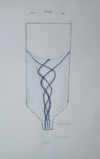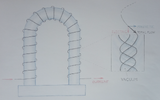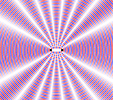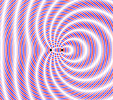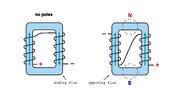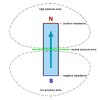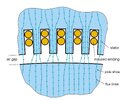If we take empty bottle, preferably of cylindrical shape, fill it with water and flip it upside down, we observe how slow the water flows out of the bottle. As soon as a little bit of water escapes from the bottle, everything pauses and the bottle has to breathe in a bubble of air. Once the bubble unites with the air in the bottle, everything repeats. There are two forces fighting each other. There is inertia of the water accelerated by gravity, or weight of the water, which is pointing down and there is elastic force, or deformation, of the air in the bottle which is pointing up in this case. As the water tries to escape, the air in the bottle is stretched, because its volume is forcefully increased by the water, and becomes negatively charged, meaning the pressure of the air drops below the atmospheric pressure surrounding the bottle, and the air now acts as a spring that prevents the water from escaping. The water is now being pulled up by the air in the bottle and also pulled down by gravity, so it is under tension. At that time the bubble of air enters into the bottle, because water, being liquid, cannot support tension. That is why fluids can be poured, because they can be easily split even into droplets. That is why fluids are fluids, they cannot be stretched without restricting their flow. Once the bubble of air reaches the air pocket in the bottle, the pressure difference is relieved and again a little bit of water escapes, because the force due to weight is dominant. And the entire process repeats. There are two opposite forces, which, because of the need for balance, take turns based on which one is stronger. There are also two flows. Flow of water, which is downward, and counter-flow of air, which is upward. Air can be seen as lack of water, therefore their flow have to be opposite. But the volumes exchanged are the same. And the water is very slow to escape from the bottle because the process is discontinuous, that is, in turns, and the swings in the forces are large and therefore create large imbalance, before one or the other force becomes stronger and again restores balance, albeit only temporarily.
We can make the water flow much quicker, if we again fill the bottle with water, approximately to three quarters, so there is enough air in the bottle where the water can be displaced to the sides, but now as soon as we flip it upside down, we shake it horizontally. We can also add a bit of circular motion in horizontal plane to the shaking. If we do it with enough strength, then we can observe a vortex being created in the water, as the water is flowing out of the bottle. After the vortex is created we can hold the bottle still, because the flow is self-sustaining, and we can observe it. Now the water flows much faster compared to the previous case. Once the water starts to rotate, the inertia of the water creates centrifugal forces acting on the water which will push the water outward, or onto the sides of the bottle. At that time a water vacuum is created in the center of the bottle, where the air can flow freely in direction opposite to the water flow. We observe separation of water flow and air counter-flow, but this time they are continuous. There is still dynamic balance, but the swings in the two forces, one being inertial, which is centrifugal and the other being elastic, which is centripetal, are very small, almost nonexistent. We can observe pulsing in the vortex structure. The vortex structure changes the direction of the balancing forces. Whereas the forces in the first case were in direction parallel to the flow, thus inhibiting the flow, the forces in the second case are more perpendicular to the flow.
We can do the same with current. We take an U-shaped bar made of soft iron, and a square bar that fits across the prongs. If soft iron is not available, mild steel is good. The square bar should fit good on the prongs so that there is no gap. The size is not important, but the bigger, the more powerful effect. Then we take insulated wire and wind at least couple hundred turns along the length of the U-shaped bar. The more turns the better. The gauge of the wire is not important, but the thicker the wire, the more current it can pass and the more powerful effect. After assembling everything we can observe if the U-shape bar performs like an electromagnet, by placing the square bar an inch apart from the prongs, and passing current through the wire. If the bar snaps to the prongs, then everything works as intended. We can feel how much effort it takes to pull off the bar from the prongs while the electromagnet is energized. But the main point is to show that even after disconnecting the wire from the battery, or power supply, the bar is still attached firmly to the prongs and it takes considerable effort to separate it. We might think that maybe we created permanent magnet by magnetizing the U-shaped bar, but this is not the case, because after separating the square bar apart from the prongs, the bar won't stick to it anymore without again passing current through the wire.
To do this, we put the square bar on the prongs and pass current through the wire for a couple of seconds and then disconnect it. At that time, the square bar is firmly attached to the prongs, even though there is no current in the wire. But there is current in the bars, which now form closed circuit and the current holds the bars together. If we did the experiment with the water bottle, we can explain what happened. By wrapping the wire around the U-shape bar and passing current through the wire, we created the same vortex structure as we did in the water. In the case of the water bottle we had to shake it in circular pattern to create the vortex, but here because the wire is wrapped in circular, or spiral pattern, the current passing through the wire does all the work for us. In this case the vortex is created in the universal medium, which has properties similar to water. Because the current now flows in spiral pattern inside the bars, the flow is enhanced and there is no loss at all.
The mechanism is the same as in the water. There are again two balancing forces, one inertial, trying to separate everything, creating imbalance, pointing away from the center, and the other is elastic, trying to unite everything, creating balance, pointing toward the center. Once the rotation of the medium is achieved, the flow is expanding, and slowing down, due to inertial forces. At that time, vacuum is created in the center of the bars, and the vacuum is now pulling the flow toward the center, and also accelerating the flow. Because of acceleration, the inertial forces gain strength and again expand the flow, creating vacuum, and this repeats in infinite cycle. There is pulsing circulating kinetic, or inertial field, and due to this field also pulsing elastic field. The bars are really held together because of the vacuum. The circulating inertial field just creates the vacuum.
We might ask why does it help to have spiral flow. In the case of the water bottle, there were two flows, that were competing against each other, and by creating the vortex, they were separated and therefore enhancing the flow. But here, there is only universal medium and nothing else. But if that were so, then the flow would not be impeded even in ordinary wire, because there would be acting nothing against the flow. We might thing that it is the electrons, bumping into the matter, that creates losses. But the same material is present, no matter what kind of flow we observe, and electrons being very big and massive have nothing to do with this flow. The universal medium can flow easily through matter, whereas the electrons can't.
One possible explanation, supported by observation, is that the universal medium is composed of two types of universal particles, that have opposite properties. They are the smallest particles that exist, and everything is made of these particles. Therefore, there are two flows associated with these particles flowing against each other, and by creating the spiral flow, the flows are much better separated and therefore the flow is unimpeded. It can be shown that the circulating current is present even after months, and years, after the device was energized only for couple of seconds, and it takes the same effort to separate the two bars, as on the first day. Once the circulating current is created, it will flow indefinitely.
